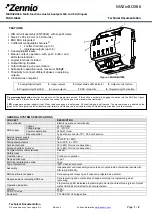Overview
MCF52110 ColdFire® Integrated Microcontroller Reference Manual, Rev. 1
1-12
Freescale Semiconductor
Preliminary
with software-selectable duty rates from 0% to 100%. The timer supports PCM mode, which results in
superior signal quality when compared to that of a conventional PWM. The PWM outputs have
programmable polarity, and can be programmed as left aligned outputs or center aligned outputs. For
higher period and duty cycle resolution, each pair of adjacent channels ([7:6], [5:4], [3:2], and [1:0]) can
be concatenated to form a single 16-bit channel. The module can, therefore, be configured to support 8/0,
6/1, 4/2, 2/3, or 0/4 8-/16-bit channels.
1.2.15
Software Watchdog Timer
The watchdog timer is a 32-bit timer that facilitates recovery from runaway code. The watchdog counter
is a free-running down-counter that generates a reset on underflow. To prevent a reset, software must
periodically restart the countdown.
1.2.16
Backup Watchdog Timer
The backup watchdog timer is an independent 16-bit timer that, like the software watchdog timer,
facilitates recovery from runaway code. This timer is a free-running down-counter that generates a reset
on underflow. To prevent a reset, software must periodically restart the countdown. The backup watchdog
timer can be clocked by either the relaxation oscillator or the system clock.
1.2.17
Phase-Locked Loop (PLL)
The clock module contains a crystal oscillator, 8 MHz on-chip relaxation oscillator (OCO), phase-locked
loop (PLL), reduced frequency divider (RFD), low-power divider status/control registers, and control
logic. To improve noise immunity, the PLL, crystal oscillator, and relaxation oscillator have their own
power supply inputs: VDDPLL and VSSPLL. All other circuits are powered by the normal supply pins,
VDD and VSS.
1.2.18
Interrupt Controller (INTC)
The MCF52110 has a single interrupt controller that supports up to 63 interrupt sources. There are 56
programmable sources, 49 of which are assigned to unique peripheral interrupt requests. The remaining
seven sources are unassigned and may be used for software interrupt requests.
1.2.19
DMA Controller
The direct memory access (DMA) controller provides an efficient way to move blocks of data with
minimal processor intervention. It has four channels that allow byte, word, longword, or 16-byte burst line
transfers. These transfers are triggered by software explicitly setting a DCR
n
[START] bit or by the
occurrence of certain UART or DMA timer events.
1.2.20
Reset
The reset controller determines the source of reset, asserts the appropriate reset signals to the system, and
keeps track of what caused the last reset. There are seven sources of reset:


















